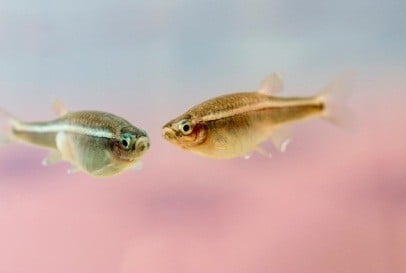Fish exposed to the antidepressant Fluoxetine, an active ingredient in prescription drugs such as Prozac, exhibited a range of altered mating behaviours, repetitive behaviour and aggression towards female fish, according to new research published on in the latest special issue of Aquatic Toxicology: Antidepressants in the Aquatic Environment.
The authors of the study set up a series of experiments exposing a freshwater fish (Fathead Minnow) to a range of Prozac concentrations. Following exposure for 4 weeks the authors observed and recorded a range of behavioural changes among male and female fish relating to reproduction, mating, general activity and aggression. On a positive note, author Rebecca Klaper, Director of the Great Lakes Genomics Center at University of Wisconsin-Milwaukee, emphasizes that the impact on behaviour is reversible once the concentration level is reduced.
“With increased aggression, in the highest level of concentration, female survivorship was only 33% compared to the other exposures that had a survivorship of 77–87.5%. The females that died had visible bruising and tissue damage,” according to Rebecca Klaper.
There is an increasing proportion of antidepressants prescriptions, and like most prescription drugs, they end up, not fully broken down, back into our aquatic ecosystems, inducing their therapeutic effects on wildlife. Although concentrations observed in our rivers and estuaries are very small, an increasing number of studies have shown that these incredibly small concentrations can dramatically alter the biology of the organisms they come in contact with.
The impact of pharmaceuticals is currently not only of interest amongst scientists but also amongst environmental regulators, industry and general public. Some US states are looking to charge pharmaceutical companies with the cost of appropriate drug disposal, some of which is currently being challenged in the courts.
“This is just one of an increasing number of studies that suggest that pharmaceuticals in the environment can impact the complex range of behaviours in aquatic organisms,” said Alex Ford, Guest Editor of the special issue of Aquatic Toxicology in which the study was published. “Worryingly, an increasing number of these studies are demonstrating that these effects can be seen at concentrations currently found in our rivers and estuaries and they appear to impact a broad range of biological functions and a wide variety of aquatic organisms.”
This is one of the reasons why Alex proposed a full special dedicated to this topic. Antidepressants in the Aquatic Environment, includes among other studies, research that demonstrates that antidepressants affect the ability of cuttlefish to change colour and a fish study whereby reproductive effects were observed in offspring whose parents who were exposed to mood stabilizing drugs.
Ford emphasizes that although the results from this study and others published in the issue show troubling results for aquatic species, this doesn’t indicate that these results are applicable to humans.
“This special issue focuses on the biology of aquatic systems and organisms and results only indicate how pharmaceuticals could potentially have effects on this particular environment.”



This is worrying as there are still many countries developing that will definitely get to the stage of pharmaceutical factories – meaning this account of pharmaceuticals in water supplies and their negative effects on nature will continue despite this uncovered information, just in different places. A big positive however is that the effects of the pharmaceuticals in nature are reversible – so pharmaceutical companies just have to get their act together in terms of how they dispose their waste and our rivers and it’s inhabitants will be a big step closer towards being healthy and less toxic. In time this uncovered information about the drastic effects of pharmaceuticals in natural water supplies will push for nature conservation and people being more careful when it comes to what the dispose into rivers, awareness just needs to be spread.
In the future this whole issue at hand will probably be regarded as human exploitation. Basically the manufacture of anti depressants in order to help the ‘weaker’ population will result in aquatic destruction. In turn this will create a vicious cycle which will only keep on getting worse. If alteration of an organism’s biology can lead to serious consequences this could only mean that the food web is disrupted somehow. We are looking at an organism’s life span and reproductive problems because not all fish are like the freshwater fish Fathead Minnow. At the same time there is great relief that pharmaceutical are being questioned about the endangerment of aquatic life.
What is the difference between humans and the fish that is being studied with this research that they can be so drastically affected when compared to humans? This bares the question that we might suffer a similar fate in the long run of using some of these pharmaceutical drugs. Is there maybe not a mammal organism that more closely resembles a human that this has been tested on so we can get a better picture of the effects it has on a life form more similar to us?
It is shocking to hear that drugs that are thought to have dissolved in one’s body could still have an effect on the environment. If this continues to happen, more than just behavior will be changed. The aggression witnessed in the female population could considerably alter the population as a whole, which could lead to extinction of the species in the particular environment. More should be done towards pharmaceutical companies and drug disposal. Companies that are responsible should help clean up their messes.
Would you please edit the title to make it grammatically correct? “Altered Behavior” would make sense. “Altered Behavioral Changes” looks like something an English professor would point at to illustrate the inability of science students to master English.